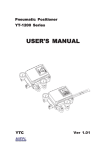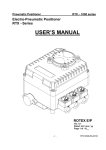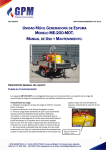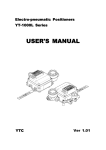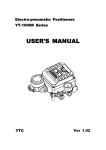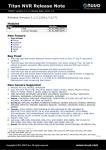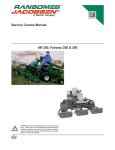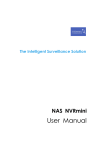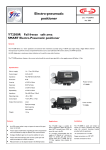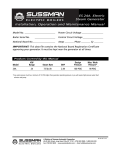Download User`s Manual - J Flow Controls
Transcript
Pneumatic Positioner Series 58 User’s Manual low JF 8 s5 rie Se w J Floies 58 Ser J Flow Controls, LLC 14 De Camp Cincinnati, OH 45216 Phone: 513-731-2900 Fax 513-731-6939 www.jflowcontrols.com Pneumatic Positioner Series 58 Introduction Thank you for choosing a J Flow Controls, LLC product. Each product is fully inspected after the production to offer you the highest quality. In order to fully utilize the product, we strongly recommend users read this manual carefully. • The manual should be given to the end user. • The manual can be changed or revised without prior notice. Any changes in the product’s specifications, structure, and/or any components may not result in immediate revision of the manual. • The manual should not be duplicated or reproduced for any purpose without approval from J Flow Controls, LLC. Manufacturer’s Warranty For your safety, it is imperative you follow the instructions in the manual. It is no the manufacturer’s liability for any damages which is caused by user’s negligence. It is not the manufacturer’s liability for any damages or accidents which resulted by alteration or modification of the product and parts. If alteration or modification is necessary, please contact the manufacturer directly. Manufacturer warrants the product from the date of original retail purchase of the product for one (1) year, except as otherwise stated. Manufacturer warranty will not cover the product if it has been subjected to abuse, accident, alteration, modification, tampering, negligence, misuse, faulty installation, lack of reasonable are, repair or service, or if the model or serial number has been altered, tampered with, defaced or removed; damages that occur in shipment, due to an Act of God, failure due to power surge and cosmetic damage. Improper or incorrectly performed maintenance voids this limited warranty. For detailed warranty information, please contact J Flow Controls, LLC. jflowcontrols.com Page 2 Pneumatic Positioner Series 58 Product Description Main Features and Functions • The product can operate normally in very extreme environment, such as vibration. • The durability has been proven after testing of 1 million times • Response time is very short and accurate • Simple part change can set 1/2 Split Range • It is economical due to less air-consumption • Direct/Reverse action can be set easily Zero & Span adjustment process is simple • Feedback Connection is easy Operation Logic 9 Out 2 Out 1 5 Supply 8 8 11 6 4 2 6 10 4 2 12 7 3 Out 2 Out 1 9 5 Supply 7 3 15 14 13 14 1 1 16 16 13 11 10 15 12 Input Signal Pressure Input Signal Pressure Series 58R Series 58 Bellows (1) push flapper (2) if input pressure increases. Then the gap between nozzle (3) and flapper (2) increases, which results pressure in upper spool (5) exhaustion. This would cause spool (5) to rise upward. As the spool (5) rises, it pushes format (8) and the air pressure will be supplied to the actuator (10). As the actuator’s inner pressure increases, the actuator stem (12) will move. For graphical diagram, please refer to Figure 1. Input Signal Input Bellows Mechanism Flapper & Nozzle Mechanism Pilot Relay Actuator Cam Mechanism Feedback Lever Stroke Output Stabilizer Spring Feedback Spring Figure 1 jflowcontrols.com Page 3 Pneumatic Positioner Series 58 Label Description MODEL NO: SERIES 58 INPUT SIGNAL 3~15psi (0.2 ~ 1.0lgf/cm2) SUP. PRESSURE: 20~100psiG (1.4~7.0kgf/cm2G) SERIAL NO: 1234567890 P/P POSITIONER Model Number: Indicates model name and any options Input Signal: Indicates current input signal range Supply Pressure: Indicates the range of supply pressure Serial Number: Indicates unique serial number Suffix Symbol Series 58 follows suffix symbols as follows: Series 58 1 2 3 4 5 1 Motion Type L R : : Linear Rotary 2 Acting Type S D : : Single Double 3 Feedback Lever Series 58L 1 2 3 4 : : : : 10 ~ 40mm 30 ~ 70mm 60 ~ 100mm 100 ~ 150mm Feedback Lever Series 58R 1 2 3 4 5 : : : : : M6 x 40L M6 x 63L M8 x 40L M8 x 63L NAMUR 4 Connection Type 1 2 : : PT NPT 5 Ambient Temp S H L : : : -4° F ~ 158° F -4° F ~ 248° F -40° F ~ 158° F * For special specifications, contact our sales department jflowcontrols.com Page 4 Pneumatic Positioner Series 58 Specification Category Series 58 Single Double Single Double 0.2 ~ 1.0 kgf/cm2 (3 ~ 15 psi) Input Signal Supply Pressure Series 58 10 ~ 150mm 0 ~ 90° Air Connection PT (NPT) 1/4 Gauge Connection PT (NPT) 1/8 Protection IP66 Cam Linear Ambient Temp Standard: -4° F ~ 158° F High: -4° F ~ 248° F Low: -40° F ~ 158° F Linearity +1.0% F.S. +2.0% F.S. Hysteresis +0.75% F.S. +1.0% F.S. Sensitivity +0.2% F.S. +0.5% F.S. Repeatability +0.3% F.S. +0.5% F.S. Air Consumption 3.0 LPM (Sup=1.4kgfcm2), 11LPM (Sup=4.0kgf/cm2) Flow Capacity 80LPM (Sup=1.4kgf/cm2), 200LPM (Sup=4.0kgf/cm2) Material Aluminum Die casting Weight 3.75 pounds * Test under ambient temperature of -4° F, absolute pressure of 760mmHG, and humidity of 65%. Please contact us for more detailed information. jflowcontrols.com Page 5 Pneumatic Positioner Series 58 Parts and Assembly COVER W LO J F ies 58 r e S PILOT VALVE TORQUE MOTOR FEEDBACK SHAFT ZERO UNIT SPAN UNIT BASE BODY FEEDBACK LEVER SERIES 58 COVER JF L Se OW ries 58 PILOT VALVE SPAN UNIT CAM CONNECTOR FEEDBACK SHAFT TORQUE MOTOR ZERO UNIT BASE BODY FEEDBACK LEVER SERIES 58 jflowcontrols.com Page 6 Pneumatic Positioner Series 58 Dimensions 7.35 7.32 5.24 3.01 2.36 1.67 1.36 2.76 6.51 4.80 1.71 3.04 2.36 2.56 1.57 4-M8X2.125P 4-PT(NPT)1/8 0.79 4-PT(NPT)1/4 8-MXx1.25SP DP.10 0.12 1.77 3.60 1.80 3.27 Series 58 Dimension 7.35 1.57 1.36 1.67 2.36 2.76 6.51 1.71 2.36 2.56 3.01 4.80 3.04 7.32 5.24 4-M8X2.125P 4-PT(NPT)1/8 8-MXx1.25SP DP.10 0.79 4-PT(NPT)1/4 0.12 1.77 3.60 1.80 3.27 Series 58 Dimension jflowcontrols.com Page 7 Pneumatic Positioner Series 58 Installation Safety Warning When installing positioner, please ensure to read and follow safety instructions. All input and supply pressure to valve, actuator, and other related devices must be turned off. Use bypass valve or other equipment to avoid entire system “shut down”. Make sure there no remaining pressure in the actuator Tools for Installation 1 Hexagonal wrench 2 Screw drivers (=) & (-) 3 Spanners for hexagonal head bolts Series 58 Installation The Series 58 should be installed on linear motion valve such as a globe valve or gate valve using spring return type diaphragm or piston actuator. Before installation, be sure to check for the following installation components. 1 Series 53 main body 2 Feedback lever and lever spring 3 Flange nut (bottom of Series 58) 4 4 pieces of hexagon head bolts (M8 x 1.25SP) 5 4 pieces of M8 plate washer Installation Steps (1) Proper bracket must be made in order to attach positioner on the actuator yoke. Please consider the following when making a bracket: 1 Feedback lever should be leveled at 50% of valve stroke. (Refer to step 7) 2 Feedback lever connection bar of actuator clamp should be installed at the position that the valve stroke and numbers which indicated on the feedback lever must be fitted (Refer to Step 8) (2) Attach Series 58 to the bracket, which was produced in an earlier step, by using bolts. <Figure 1> Please refer to backside of the product for size of bolts. The standard size of bolt is M8 x 1.25SP, and other bolt sizes are available. Please contact J Flow Controls, LLC. Figure <1> jflowcontrols.com Page 8 Pneumatic Positioner Series 58 (3) Attach Series 58 (with bracket) to the actuator yoke - DO NOT TIGHTEN COMPLETELY. (4) Connect Series 58 feedback lever to the actuator clamp. The gap on the Series 58 feedback lever is 2.55”. The connection bar thickness should be less than 2.48”. <Figure 2> Figure <2> (5) Connect air filter regulator to the actuator temporarily. Set supply pressure of the regulator in order to position to the actuator clamp at 50% of valve stroke. <Figure 3> Figure <3> (6) Insert connection bar into the Series 58 feedback lever. The connection bar should be inserted at the 50% point of the feedback lever, which would help to reduce hysteresis. <Figure 4> Figure <4> jflowcontrols.com Page 9 Pneumatic Positioner Series 58 (7) If connection bar does not point to 50% point, then adjust bracket or feedback link bar position. Failure to position at 50% will lower the linearity of the positioner. <Figure 5> J Flow Series 58 50% Figure <5> (8) Check valve stroke. The stroke numbers are indicated on the feedback lever. Position connection bar at the number on the feedback lever according to the valve stroke. <Figure 6> To adjust, move the bracket or connection bar. Stroke 30mm Stroke 70mm Figure <6> Note After installing Series 58 operate the vale from 0% to 100% stroke by using air filter regulator on the actuator. Both of 0% and 100%, the feedback lever should not touch the lever stopper, which is located on the backside of Series 58. <Figure 7> If the feedback lever touches the lever stopper, Series 58 should be installed further away from the center of the yoke. (9) After the proper installation, tighten all of the bolts on the bracket, the feedback lever, and the connection bar. Figure <7> jflowcontrols.com Page 10 Pneumatic Positioner Series 58 Series 58 Installation The Series 58 should be used for rotary motion valves, that is ball valve, butterfly valve using rack and pinion, scotch yoke and pinion, scotch yoke or complete type actuator, which its stem rotates 90 degrees. Before installation, be sure to check for the following installation components. 1 2 3 4 5 Series 58 main body Fork lever and lever spring 1 set of bracket (3 pieces) 4 pieces of hexagon head bolt M8 x 1.25 SP 4 pieces of M8 plate washer Series 58 Install Layout Series 58 on Fork Lever Series 58 on Namur Lever jflowcontrols.com Page 11 Pneumatic Positioner Series 58 Bracket Information Series 58 is supplied with standard bracket. The bracket can be used for Fork lever and NAMUR bracket. See <Figure 8> for more detailed information. Upper Bracket B Series 53 Upper Bracket A 0.79 NAMUR TYPE 0.79 1.18 NAMUR TYPE 1.18 NAMUR TYPE 1.97 1.97 FORK TYPE 0.79 FORK TYPE 1.18 FORK TYPE 1.97 H: 1.97 H: 1.97 H: 0.79, 1.18 H: 0.79, 1.18 Figure <8> (1) Standard actuator stem height (H) is 0.79", 1.18" or 1.97". After checking "H", assemble with the bracket as shown in <Figure 8 & 9> Actuator Stem (H) Actuator Figure <9> (2) Attach bracket Series 58 to the actuator by using hexagon-headed and wrench bolts. Size of the bracket hole is 0.236". When tightening bolts, use spring washer or similar for firm attachment to the actuator, so Series 58 will not shake by vibration or any other impact. The direction of bracket is different by the operating condition, but normally the position is installed as shown in <Figure 10>. jflowcontrols.com Page 12 Pneumatic Positioner Series 58 Figure <10> (3) Set rotation position of the actuator stem at zero point, 0%. For a single type of actuator, it is easy to check zero point, because the actuator is positioned at zero point when there is no supply pressure. If double acting actuator is used, check actuator stem's rotation direction (clockwise or counter-clockwise) by supply pressure. (4) Install the fork lever as shown in <Figure 11> after setting actuator stem at zero point. Check the direction of the actuator stem - clockwise or counter clockwise. Installation angle of the fork lever should be 45 degrees based on the linear shaft. For NAMUR shaft, the angle does not matter. Counter-Clockwise Clockwise 45 ° Figure <11> (5) After setting fork lever position, lock nuts which are assembled on bottom of the fork lever. (6) Attach Series 58 to the bracket. Fix the clamping pin on the main shaft of Series 58 and insert connection bar into the fork lever slot, so it can be locked to the fork lever spring. jflowcontrols.com Page 13 Pneumatic Positioner Series 58 Series 58 and center of the actuator stem. Bad alignment of the main shaft and the actuator stem lowers Series 58 durability, because too much force will be on the main shaft of Series 58 <Figure 12>. Fork Lever Clamping Pin Connection Bar Main Shaft Figure <12> (7) Tighten Series 58 base and the bracket with hexagon-headed bolts and plate washer. It is recommended to tighten four bolts after checking Series 58 position (Figure 13>. Figure <13> jflowcontrols.com Page 14 Pneumatic Positioner Series 58 Piping Connection Note • To avoid moisture, oil or dust into the product, please carefully make selection of supply pressure compressor. • It is recommended to attach air filter regulator before supply port of Series 58. Supply Pressure Condition 1. Dry air with at least 50°F lower than ambient temperature. 2. Avoid dusty air. Filter can only sort 5 micron or larger. 3. Avoid any oil. 4. Comply with ANSI/ISA-57.3 1975 (R188); ISA S7.3-1975 (R1981) 5. Not to be used beyond the range of 1.4 - 7 kgf/cm2 (140 - 700 kPA) 6. Set air filter regulator's supplied pressure 10% higher than actuator's spring range pressure. Pipe Condition 1. Make sure inside of pipe is emptied. 2. Do not use pipeline that is squeezed or has hole. 3. To maintain flow rate, use the pipeline that has more than 0.24 inches inner diameter. (0.39 inches outer diameter). 4. Do not use extremely long pipeline system. It may affect flow rate due to the friction inside of the pipeline. Piping connection with actuator Single Acting Actuator Series 58 Series single acting type is set to use OUT1 port. OUT1 port should be connected with supply pressure port from actuator when using single acting type of spring return actuator <Figure 14 & 15>. OUT1 OUT1 Figure <14> jflowcontrols.com Figure <15> Page 15 Pneumatic Positioner Series 58 Double Acting Actuator For Series 58 double acting type, when inputting current signal, supply pressure is out from OUT1. Please refer to <Figure 16 & 17>. OUT1 OUT2 OUT2 OUT1 Figure <17>: Series 58 Figure <16>: Series 58 Adjustments Adjustment - Cam 1. Direction of actuator's stem rotation must be checked when supply signal is supplied. When actuator's stem rotates clockwise, the face of cam must be shown "DA". On the other hand, when the stem rotates counterclockwise, adjust cam so "RA" shows on the face of cam. 2. Check whether actuator's angle is at the initial point. 3. After checking the initial point, release the hexagonal flange nut and adjust the position of the bearing so it is a 0 point <Figure 18>. 4. When produced, the cam is set as "RA. Counter-Clockwise Clockwise Cam reference line Bearing Reverse Acting Direct Acting Figure <18> jflowcontrols.com Page 16 Pneumatic Positioner Series 58 Adjustment - Zero Point 1. Set supply signal at 3 psi and rotate adjuster clockwise or counter-clockwise to adjust actuator's rotation angle <Figure 19>. 2. When adjusting zero for single actuator, rotation angle is equal to positioner's pressure gauge. Figure <19> Adjustment - Span Series 58L Series 58R Lock Screw Lock Screw SPAN SPAN Figure <20> 1. After setting zero, rotate Span screw so supply signal reaches at the span point on the indicator. 2. Changing span point affects zero point setting. So zero setting must be set again. After setting zero point, confirm the span point. This step must be repeated until both points are properly set. 3. If 1/2 split range is used, Series 58 can be used after span and zero point are set. For Series 58 with 1/2 split range, the span spring must be changed. 4. After setting is completed, tighten Lock Screw. <Figure 20>. jflowcontrols.com Page 17 Pneumatic Positioner Series 58 Adjustment - A/M Switch (Auto/Manual) 1. A/M switch adjusts the valve operation to automatic or manual. 2. When produced, Series 58 is set at the "A (Automatic)". If user prefers the positioner's setting as "M (Manual)". The setting can be changed by turning the switch counter-clockwise. <Figure 21> 3. If it is set as "M (Manual)", the air pressure will be supplied to the actuator directly. Always set back to "A (Automatic)" after setting change. 4. If OUT2 in single acting actuator or double acting actuator is used, A/M Switch will not operate. Lock Screw Seat Adjuster Auto Manual Switch Adjustment - Seat Adjuster 1. Seat adjuster is set according to the customer's request before the positioner is delivered. Please do not adjust the Seat Adjuster. 2. Seat Adjuster is used for double acting actuator always. Please do not touch the Seat Adjuster because it can affect the positioner's performance. jflowcontrols.com Page 18 Pneumatic Positioner Series 58 Trouble Shooting Positioner does not respond to the input signal 1. Check supply pressure level. The level must be at lest 1.4 kgf/cm2. 2. Check if input signal is properly supplied to the positioner. The signal should be 3-15 psi. 3. Check if the positioner's nozzle has been blocked. Also, check if the pressure is supplied to the positioner and the pressure is being exhausted through the nozzle. If the nozzle has been blocked by any substances, please send the product to J Flow for repair. 4. Check if feedback lever has been installed properly. The pressure of OUT1 reaches exhausting pressure level and does not come back down. 1. Check A/M Switch. If the switch has been damaged, replace the switch or pilot relay-valve. 2. Check for a gap or damages between the nozzle and the flapper. If damaged, please send the product to J Flow for repair. The pressure is exhausted only by A/M Switch 1. Check if the positioner's nozzle has been blocked. Also, check if the pressure is supplied to the positioner and the pressure is being exhausted through the nozzle. If the nozzle has been blocked by any substances, please send the product to J Flow for repair. Hunting occurs 1. Check if safety spring has been displaced. (Next to Pilot Relay Valve). 2. Check if the size of actuator is too small. If so, insert an orifice in order to reduce the pressure flow rate. 3. Check if there is any friction between the valve and the actuator. If so, increase actuator's size or reduce the friction level. Actuator only operates by On/Off 1. Check pipe connection. 2. Check Cam direction. Linearity is too low 1. Check if the feedback lever is properly installed. Especially check if the feedback lever is parallel to the ground at 50% point. 2. Check if zero and span have been properly adjusted, that is not too low or not too high. 3. Check if supply air pressure level is stable from the regulator. If the level is unstable, replace the regulator. Hysteresis is too low 1. In case of double acting actuator, check if seat adjustment has been properly done. Please contact J Flow Controls for any further inquires regarding the seat adjustment. 2. Backlash can occur when feedback lever and lever spring is loosen. To avoid backlash, adjust the lever spring. 3. Check if the connection bar to the feedback lever is tightly fastened. jflowcontrols.com Page 19 J Flow Controls, LLC 14 de Camp Avenue Cincinnati, OH 45216 Phone: 513-731-2900 Fax: 513-731-6939 www.jflowcontrols.com






















